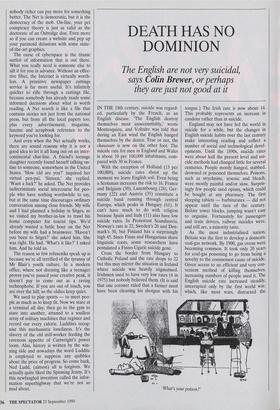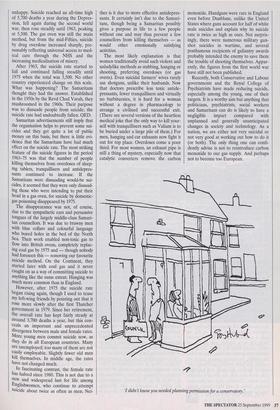DEATH HAS NO DOMINION
The English are not very suicidal, they are just not good at it
IN THE 18th century, suicide was regard- ed, particularly by the French, as an English disease. 'The English destroy themselves most unaccountably,' wrote Montesquieu, and Voltaire was told that during an East wind the English hanged themselves by the dozen. True or not, the chaussure is now on the other foot. The suicide rate for men in England and Wales is about 10 per 100,000 inhabitants, com- pared with 30 in France.
With the exception of Holland (13 per 100,000), suicide rates shoot up the moment we leave English soil. Even being a Scotsman increases the risk to 16. France and Belgium (30), Luxembourg (28), Ger- many (22) and Austria (35) constitute a suicide band running through central Europe, which peaks in Hungary (61). It can't have much to do with religion because Spain and Italy (11) also have low suicide rates. In Protestant Scandinavia, Norway's rate is 22, Sweden's 26 and Den- mark's 30, but Finland has a surprisingly high 45. Since Finns and Hungarians share linguistic roots, some researchers have postulated a Finno-Ugaric suicide gene.
Cross the border from Hungary to Catholic Poland and the rate drops to 22 but this may mirror the situation in Ireland where suicide was heavily stigmatised. Irishmen used to have very low rates (4 in 1975) but nobody believed them. (It is said that one coroner ruled that a farmer must have been cleaning his shotgun with his tongue.) The Irish rate is now about 14. This probably represents an increase in candour rather than in suicide.
England may not have led the world in suicide for a while, but the changes in English suicide habits over the last century make interesting reading and reflect a number of social and technological devel- opments. Until the 1890s, suicide rates were about half the present level and sui- cide methods had changed little for several centuries. People mostly hanged, stabbed, drowned or poisoned themselves. Poisons, such as strychnine, arsenic and bleach, were mostly painful and/or slow. Surpris- ingly few people used opium, which could be bought at any pharmacy. The first sleeping tablets — barbiturates — did not appear until the turn of the century. Before tower blocks, jumping wasn't easy to organise. Fortunately for passengers and train drivers, railway suicides were, and still are, a minority taste.
As the most industrialised nation, Britain was the first to develop a domestic coal-gas network. By 1900, gas ovens were becoming common. It took only 20 years for coal-gas poisoning to go from being a novelty to the commonest cause of suicide. Given access to an efficient and very con- venient method of killing themselves, increasing numbers of people used it. The English suicide rate increased steadily, interrupted only by the first world war, which, like most wars, distracted the `What's your poison?' unhappy. Suicide reached an all-time high of 5,700 deaths a year during the Depres- sion, fell again during the second world war, then rose steadily until 1963, peaking at 5,500. The gas oven was still the main method, but from the mid-Fifties, suicide by drug overdose increased sharply, pre- sumably reflecting universal access to med- ical care through the NHS and the increasing medicalisation of misery.
After 1963, the suicide rate started to fall and continued falling steadily until 1975 when the total was 3,500. No other country experienced change on this scale. What was happening? The Samaritans thought they had the answer. Established in the 1950s by the Revd Chad Varah, they mushroomed in the 1960s. Their purpose was to dissuade people from suicide; the suicide rate had undoubtedly fallen. QED.
Samaritan advertisements still imply that the organisation helps to prevent some sui- cides and they get quite a lot of public money on this basis, but there is little evi- dence that the Samaritans have had much effect on the suicide rate. The most striking feature of the suicide figures in the period 1963-75 was that the number of people killing themselves from overdoses of sleep- ing tablets, tranquillisers and antidepres- sants continued to increase. If the Samaritans were dissuading would-be sui- cides, it seemed that they were only dissuad- ing those who were intending to put their head in a gas oven, for suicide by domestic- gas poisoning disappeared by 1975.
The disappearance was not, of course, due to the sympathetic ears and persuasive tongues of the largely middle-class Samari- tan counsellors. It was due to brawny men with blue collars and colourful language who bored holes in the bed of the North Sea. Their work enabled non-toxic gas to flow into British ovens, completely replac- ing coal gas by 1975 and — though nobody had foreseen this — removing our favourite suicide method. On the Continent, they started later with coal gas and it never caught on as a way of committing suicide to anything like the same extent. Hanging was much more common than in England.
However, after 1975 the suicide rate began rising again, though I used to tease my left-wing friends by pointing out that it rose more slowly after the first Thatcher government in 1979. Since her retirement, the overall rate has kept fairly steady at around 3,700 deaths a year, but this con- ceals an important and unprecedented divergence between male and female rates. More young men commit suicide now, as they do in all European countries. Many are unemployed; too many of them are not easily employable. Slightly fewer old men kill themselves. In middle age, the rates have not changed much. In fascinating contrast, the female rate has halved since 1980. This is not due to a new and widespread lust for life among Englishwomen, who continue to attempt suicide about twice as often as men. Nei- ther is it due to more effective antidepres- sants. It certainly isn't due to the Samari- tans, though being a Samaritan possibly gives a purpose in life to a few people without one and may thus prevent a few counsellors from killing themselves — as would other emotionally satisfying activities.
The most likely explanation is that women traditionally avoid such violent and unladylike methods as stabbing, hanging or shooting, preferring overdoses (or gas ovens). Even suicidal farmers' wives rarely use shotguns, unlike their husbands. Now that doctors prescribe less toxic antide- pressants, fewer tranquillisers and virtually no barbiturates, it is hard for a woman without a degree in pharmacology to arrange a civilised and successful exit. (There are several versions of the heartless medical joke that the only way to kill your- self with tranquillisers such as Valium is to be buried under a large pile of them.) For men, hanging and car exhausts now fight it out for top place. Overdoses come a poor third. For most women, an exhaust pipe is still a thing of mystery, especially now that catalytic converters remove the carbon monoxide. Handguns were rare in England even before Dunblane, unlike the United States where guns account for half of white male suicides and explain why its suicide rate is twice as high as ours. Not surpris- ingly, there were numerous military gun- shot suicides in wartime, and several posthumous recipients of gallantry awards probably intended the enemy to save them the trouble of shooting themselves. Appar- ently, the figures from the first world war have still not been published.
Recently, both Conservative and Labour governments and the Royal College of Psychiatrists have made reducing suicide, especially among the young, one of their targets. It is a worthy aim but anything that politicians, psychiatrists, social workers and Samaritans can do is likely to have a negligible impact compared with unplanned and generally unanticipated changes in society and technology. As a nation, we are either not very suicidal or not very good at working out how to do it (or both). The only thing one can confi- dently advise is not to reintroduce carbon monoxide to our gas supply. And perhaps not to become too European.
7 didn't know you needed planning permission for a conservatory.'



























































































 Previous page
Previous page